Do you have a question about the Canon 814XL Electronic and is the answer not in the manual?
Overview of the Super 8 movie camera and its improvements for better quality.
Details on the variable shutter angle for different shooting conditions and effects.
Explains the built-in pulse generator for synchronous sound recording.
Highlights features enabling shooting in dim light conditions.
Describes increased viewfinder brightness and high-quality lens for faithful color reproduction.
Details on abundant viewfinder information and high accuracy servo EE system.
Key specs like type, picture size, lens details, and construction.
Explains macro capabilities and viewfinder details including dioptric adjustment.
Details on EE mechanism, light metering range, and film speed.
Covers film ASA setting, exposure compensation, filming speeds, shutter, drive system, and battery check.
Describes main switch, footage/film end warnings, recording system, and included accessories.
Sequence of actions from unfolding grip to adjusting eyepiece and controls.
Steps for taking the camera and looking into the viewfinder.
Inserting film, setting main switch, shutter dial, and exposure.
Adjusting focus, deciding composition, and capturing the shot.
Instructions on using the hand grip, strap, and lens hood for safe operation.
Detailed steps for inserting and securing batteries in the grip compartment.
Procedure to verify battery power status using the indicator lamp.
Adjusting the eyepiece for clear vision using the split-image screen.
Steps for inserting and securing the film cartridge.
Operating the main switch and selecting filming speeds (9, 18 fps, single frame).
Using the dial for manual exposure control.
Adjusting shutter opening angle for different lighting conditions.
Using the knob for exposure compensation.
Checking film movement via the viewfinder indicator.
Guidance on holding the camera steady for better shots.
Explanation of indicators like aperture scale, warning marks, and LEDs.
Using the power and manual zoom systems for focal length changes.
How to adjust focus using the viewfinder and distance scale.
Techniques for framing subjects using the viewfinder.
How to read the exposure indication window.
Steps for releasing the shutter smoothly.
Interpreting over/under exposure warnings and corrections.
Using the adjustment knob for compensation in backlit or bright scenes.
Indicators for film movement and end-of-film alerts.
Steps to open the cover and remove the exposed film.
Procedure and considerations for interchanging film cartridges.
Explains the built-in filter for color temperature adjustment.
How to remove the CCA filter using an adapter.
Performing close-up shots of small subjects with the macro mechanism.
Adjusting focus for macro shots and resetting the mechanism.
Using the dial for manual exposure control.
How the shutter blades control exposure and fading.
Settings for shutter opening angle and speed.
How shutter angle controls fading effects.
Step-by-step guide to achieve a fade-out effect.
Step-by-step guide to achieve a fade-in effect.
Using the lock for continuous or remote shooting.
Connecting and preparing for remote shooting.
Executing shots with remote control and proper release sequence.
Using the remote switch or lever for single frame capture.
Using the self-timer for unmanned or self-portraits.
Using the timer for shooting at set intervals.
Synchronizing flash for titles and animation.
Using the switch for high-speed slow motion filming.
Connecting for synchronized sound recording using specific cords and recorders.
Utilizing zooming for creative movie effects and smooth transitions.
Advice on moderating zoom use and using tripods for clarity.
Moving the camera horizontally for wide views or following subjects.
Moving the camera vertically up or down.
Using macro-cinematography for titles and copy work.
Special lens for titles, literature, plants, and insects.
Information on filters, self-timer, and interval timer accessories.
Accessory for macro-cinematography and copy work.
Warnings about viewfinder cover, lens care, and water damage.
Guidance on storing the camera, safety lock, and high temperature caution.
Precautions for low temperatures and battery performance.
Advice on adapting the camera to temperature changes to prevent condensation.
Overview of the Super 8 movie camera and its improvements for better quality.
Details on the variable shutter angle for different shooting conditions and effects.
Explains the built-in pulse generator for synchronous sound recording.
Highlights features enabling shooting in dim light conditions.
Describes increased viewfinder brightness and high-quality lens for faithful color reproduction.
Details on abundant viewfinder information and high accuracy servo EE system.
Key specs like type, picture size, lens details, and construction.
Explains macro capabilities and viewfinder details including dioptric adjustment.
Details on EE mechanism, light metering range, and film speed.
Covers film ASA setting, exposure compensation, filming speeds, shutter, drive system, and battery check.
Describes main switch, footage/film end warnings, recording system, and included accessories.
Sequence of actions from unfolding grip to adjusting eyepiece and controls.
Steps for taking the camera and looking into the viewfinder.
Inserting film, setting main switch, shutter dial, and exposure.
Adjusting focus, deciding composition, and capturing the shot.
Instructions on using the hand grip, strap, and lens hood for safe operation.
Detailed steps for inserting and securing batteries in the grip compartment.
Procedure to verify battery power status using the indicator lamp.
Adjusting the eyepiece for clear vision using the split-image screen.
Steps for inserting and securing the film cartridge.
Operating the main switch and selecting filming speeds (9, 18 fps, single frame).
Using the dial for manual exposure control.
Adjusting shutter opening angle for different lighting conditions.
Using the knob for exposure compensation.
Checking film movement via the viewfinder indicator.
Guidance on holding the camera steady for better shots.
Explanation of indicators like aperture scale, warning marks, and LEDs.
Using the power and manual zoom systems for focal length changes.
How to adjust focus using the viewfinder and distance scale.
Techniques for framing subjects using the viewfinder.
How to read the exposure indication window.
Steps for releasing the shutter smoothly.
Interpreting over/under exposure warnings and corrections.
Using the adjustment knob for compensation in backlit or bright scenes.
Indicators for film movement and end-of-film alerts.
Steps to open the cover and remove the exposed film.
Procedure and considerations for interchanging film cartridges.
Explains the built-in filter for color temperature adjustment.
How to remove the CCA filter using an adapter.
Performing close-up shots of small subjects with the macro mechanism.
Adjusting focus for macro shots and resetting the mechanism.
Using the dial for manual exposure control.
How the shutter blades control exposure and fading.
Settings for shutter opening angle and speed.
How shutter angle controls fading effects.
Step-by-step guide to achieve a fade-out effect.
Step-by-step guide to achieve a fade-in effect.
Using the lock for continuous or remote shooting.
Connecting and preparing for remote shooting.
Executing shots with remote control and proper release sequence.
Using the remote switch or lever for single frame capture.
Using the self-timer for unmanned or self-portraits.
Using the timer for shooting at set intervals.
Synchronizing flash for titles and animation.
Using the switch for high-speed slow motion filming.
Connecting for synchronized sound recording using specific cords and recorders.
Utilizing zooming for creative movie effects and smooth transitions.
Advice on moderating zoom use and using tripods for clarity.
Moving the camera horizontally for wide views or following subjects.
Moving the camera vertically up or down.
Using macro-cinematography for titles and copy work.
Special lens for titles, literature, plants, and insects.
Information on filters, self-timer, and interval timer accessories.
Accessory for macro-cinematography and copy work.
Warnings about viewfinder cover, lens care, and water damage.
Guidance on storing the camera, safety lock, and high temperature caution.
Precautions for low temperatures and battery performance.
Advice on adapting the camera to temperature changes to prevent condensation.
| Recording System | Super 8 |
|---|---|
| Lens | Canon Zoom Lens |
| Maximum Aperture | f/1.4 |
| Exposure | Automatic |
| Weight | 1.2 kg |
| Focus | Manual |
| Frame rates | 18, 24 fps |
| Film Speed | 25 ASA |
| Type | Super 8 movie camera |
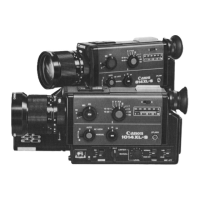
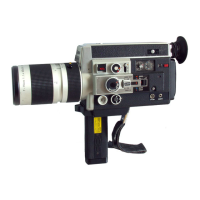
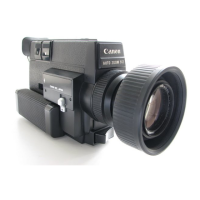
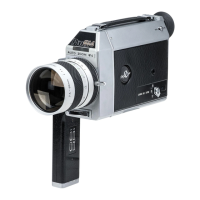
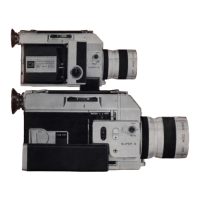

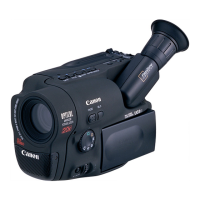
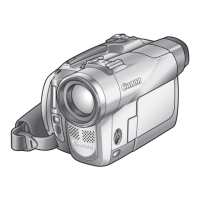

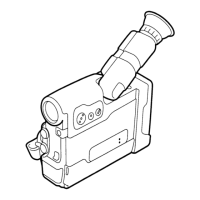
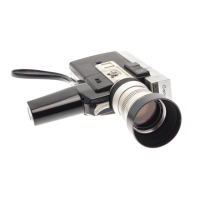
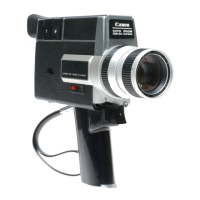
